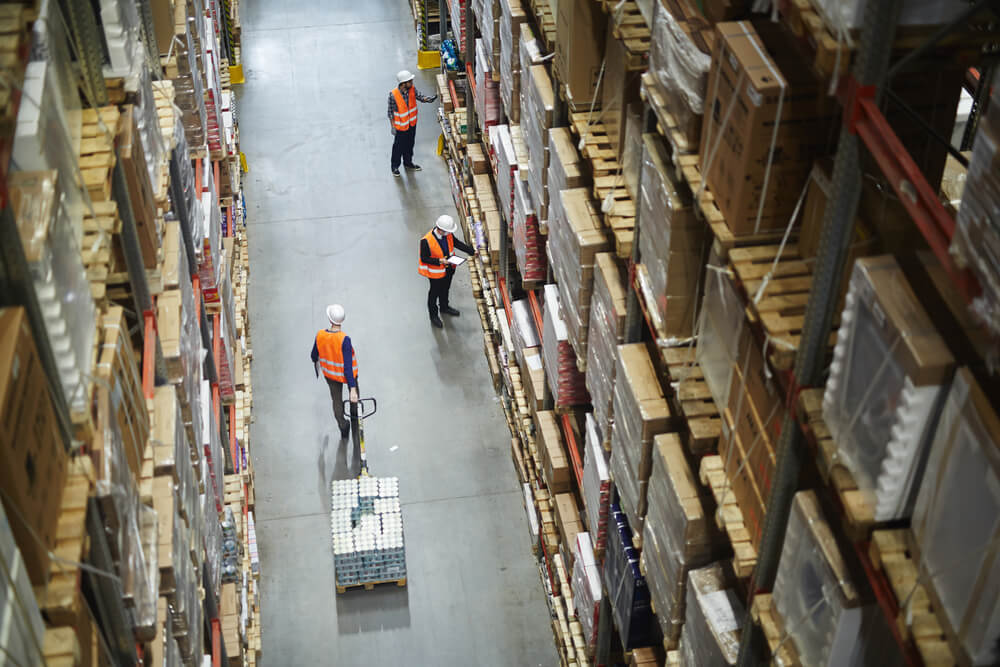Manufacturing Supply Chain Management – Best Practices for SMEs
Supply chain management encompasses everything from negotiating vendor contracts for raw materials to handling returns of a product. While it is a central concept for any company producing or selling physical goods or even services, this post focuses on the importance and best practices of SCM from the perspective of small and medium manufacturers.

What is manufacturing supply chain management?
Supply chain management (SCM) is a central concept in commerce that refers to the management of everything related to the flow of goods of a company. It revolves around every process that plays a part in raw materials being transformed into finished products and also involves aspects of after-sale activities like handling warranty claims and returns.
Manufacturing supply chain management includes all aspects of business that deal with physical goods and their logistics: inventory optimization, vendor management, logistical processes like shipping, distribution, and delivery, but also manufacturing processes such as WIP (work in process) inventory management, production scheduling, capacity planning, demand forecasting, etc.
The role of SCM is to make sure that the supply of goods is as streamlined as possible – that raw materials make it to the warehouse or production facility at just the right time and in the right quantity; that production capacities match demand as closely as possible; and that lead times and product costs stay minimal. As such, SCM can be seen as part of the larger inventory management process.
What are supply chains?
A supply chain is the whole distance that a product travels from the beginning of its manufacturing effort to finished sales. Far more than just logistics management, it comprises the sum of processes, people, businesses, activities, information, and resources that are needed to get a product or service from scratch to consumers.
Therefore, a supply chain includes not just raw materials but also the procurement management of the materials. On the other end of the pipeline, it is not just finished goods, but also their distribution network, logistics partners, and returns.
All of the organizations that constitute a supply chain are joined together through physical and information flows. Physical flows are the transformation, movement, and storage of goods and materials. Information flows, on the other hand, allow the various players in a respective supply chain to coordinate plans and control the day-to-day flow of goods throughout the supply chain.
The 5 main components of manufacturing supply chain management
There is no single correct way to manage a supply chain because there are countless different ways of doing business. Still, supply chain management systems usually consist of five essential phases: strategy, sourcing, manufacturing, delivery, and returns. Let’s go over these in a bit more detail.
- Planning and strategy: Every organization must plan and manage all the resources needed to meet customer demand for their product or service. The supply plan should factor in everything from material availability and production capacity to labor and equipment requirements, logistical constraints, budgets, etc. The more supply-related aspects of production are considered in the supply plan, the fewer surprises one can expect down the line. The logistics of the production effort should ideally be considered already in the design phase of the product itself. A supply plan can go into various levels of depth with planning, for example in a multi-level supply planning approach.
- Sourcing: Ensuring high-quality raw materials from reputable vendors is an essential aspect of any production effort. The process does not end once the suppliers are under contract. Instead, the supply chain manager is tasked with continuous vendor management. Sourcing also involves continuous procurement planning and purchase order management (ordering, delivery, authorizing payments, etc.) throughout the manufacturing process. The resilience of the supply side of production also needs to be accounted for. For example, through building long-lasting supplier relationships or gaining alternative sources that help ensure timely material deliveries even amidst market disruptions.
- Manufacturing: This central phase in supply chain management details all processes related to in-house production i.e., the transformation of raw materials (and services) into finished goods. Things to take into account in the SCM system include production efficiency, planning and scheduling, inventory optimization, quality assurance, packaging, etc. Most manufacturing companies measure the quality, production output, and worker productivity of manufacturing processes to ensure that the company is making products that meet all quality standards. Manufacturing-centric key performance indicators (KPIs) are often used to better measure the processes.
- Delivery and logistics: This phase entails the logistics of the whole production operation. Coordinating customer orders, scheduling deliveries, dispatching loads, creating and sending invoices, receiving payments, etc., all fall into the delivery phase. Here too, the resilience of the system should be factored in – an extra distribution partner or delivery method might often come in handy and contributes to a professional brand image, should disruptions occur. For example, while you might have designated vehicles for shipping, outsourcing delivery to a logistics company may prove a lower-cost alternative in some circumstances.
- Returns and after-sales: For the vast majority of commercial products, an SCM effort needs to have in place policies regarding customer returns and warranty care. Sure, an ideal product is one that never breaks down or needs repairs, but the reality is that mistakes and defects are inevitable. Foresight into developing a functional and cost-effective system for after-sales equals more customer satisfaction in the long run. The capacity of supply chains to be unidirectional is an increasingly important factor for today’s manufacturers. Suppliers and producers need networks that are quick to respond and flexible in taking back defective, extra, or unwanted products.
Are supply chain disruptions the new normal?
In the not-so-distant past, basic supply chains were quite straightforward and complex SCM was practically the exclusive worry of large multinational companies. A small business had a few long-standing suppliers with locally sourced materials. Prices and lead times were largely stable and fluctuated only with the hum of the holiday season.
In recent years, however, and especially after the pandemic, an increasingly globalized marketplace and near-constant supply chain disruptions have become the new normal across the entire manufacturing industry. A 2022 study by Deloitte and Manufacturers Alliance, points out that the era of simple supply chains is essentially gone for good.
Shipping delays, raw material shortages, rising shipping prices, and the resulting production planning and inventory management issues have become mainstays in manufacturing as a whole. Increasing control over one’s supply chain by implementing effective SCM practices is therefore increasingly important for companies of any size. This goes double for smaller players that need to juggle tight profit margins and have fewer resources for backups.
The importance of SCM for manufacturers
Supply chain management is a natural part of any company purveying physical goods, be it distributors, retailers, or manufacturers. Still, SCM includes some distinct considerations for the latter that we will look at next.
Manufacturing has innate complexities
Manufacturing supply chains are generally far more complicated than distribution. Materials and components need to converge with labor and processing in a timely, planned-out manner, and in many consecutive instances. This implies precise forecasting and capacity planning to adequately schedule production. It also means that inventory optimization efforts need to take into account a number of constraints absent in most distribution operations.
Manufacturing accounting is also more complicated as every step in the supply chain incurs extra value and added costs that need timely consolidating.
Outsourcing affects global supply chains
Another key aspect is that in the modern manufacturing landscape, one brand often has several companies contributing to manufacturing its products. With the rising complexity of product lines, many manufacturers especially in the SME space are relying on partial or total sub-assembly production for their revenue. Conversely, others are increasingly depending on sub-contractors to produce some or all of their components, and only assemble the final products in-house.
As a result, sub-contracting and outsourcing are seeing a big surge in a number of industries. This inevitably translates into more complicated and branching logistical chains which need extra collaboration and management to avoid costly mistakes.
Manufacturing is experiencing a digital transformation
Finally, with the onset of Industry 4.0, modern manufacturing is becoming increasingly reliant on digital technologies and solutions. Manufacturers are adopting Internet of Things (IoT) devices, implementing robotics, and utilizing machine learning. All to usher in more control over their processes by way of real-time analytics and data-based decision-making.
For supply chains and supply chain management, this means much greater visibility. End-to-end supply chain visibility, as made possible by digital transformation, allows companies to better manage the increasing complexities of their supply chains and accelerate response times, increasing control and traceability.
Manufacturing supply chain management best practices for SMEs
To end this article, here are 5 manufacturing supply chain management best practices that any small or medium manufacturer should focus on.
- Facilitate collaboration with key nodes in the supply chain. More collaboration with key supply chain partners means faster response times in case of sudden disturbances. Implement supplier relationship management practices to strengthen partnerships. Consider vendors as partners rather than service providers, simplify and facilitate back-and-forth information sharing, and check in with them frequently.
- Keep up to date with shifts in regional supply. Today’s logistics networks are dynamic and fast-changing. While it certainly makes sense to strengthen existing relationships, it’s also a good idea to keep a close eye on any news and events that can introduce opportunities or alternative sources. A continuous effort to improve the efficiency of the supply chain is among the basic tenets of effective supply chain management.
- Measure supply chain performance regularly. The only reliable way to ensure an efficient supply chain is by measuring its efficiency. This is where a number of supply chain-centric key performance indicators (KPIs) come into play. Examples of useful metrics include On-Time and In-Full Delivery, Customer Order Cycle Time, Fill Rate, Inventory Days of Supply, etc.
- Increase supply chain resilience. Utilizing production strategies like Just-in-Time (JIT) or adopting pull-type workflows is perhaps the best way to minimize waste and increase manufacturing efficiency. However, these types of optimizations are also more susceptible to disruptions. With global supply chains in turmoil, many manufacturing sectors are seeing a resurgence of Just-in-Case (JIC) manufacturing practices. This is a chief reason why you should always keep a few extra vendors on the quick dial.
- Implement manufacturing software. Lastly, implementing manufacturing software can make a decisive difference in your SCM efforts. Good MRP systems and manufacturing ERPs include built-in procurement tools as well as vendor and order management modules, integrated with the whole manufacturing operation. This provides you with real-time info on all inventory movements and introduces added visibility and traceability over the whole supply chain. The best providers also include Quality Assurance (QA), Customer Relationship Management (CRM), and Return Merchandise Authorization (RMA) modules. Recent years have seen a growing number of affordable yet capable cloud-based manufacturing ERPs hit the market. These constitute a viable and cost-effective choice for SMEs.
Key takeaways
- Supply chain management is a central concept in commerce that refers to the management of everything related to the flow of goods of a company.
- SCM includes aspects of inventory optimization, vendor management, logistical processes like shipping, distribution, and delivery, but also manufacturing aspects like production scheduling, and capacity planning, as well as customer returns and RMAs.
- The five main components of a supply chain management system are planning and strategy, procurement and sourcing, manufacturing, distribution, and returns or after-sale support.
- Manufacturing supply chain management has innate complexities compared to SCM for distributors. This is because, in manufacturing, raw materials are transformed into components through labor, introducing constraints and accounting considerations in each step of the supply chain.
- Manufacturing supply chain management best practices for SMEs include strengthening collaboration with key suppliers, regularly measuring supply chain performance, increasing supply chain resilience by building backup systems, and implementing manufacturing software for added visibility and control over the supply chain and vendors.
Frequently asked questions
Manufacturing supply chain management is the systematic process of managing all aspects of a manufacturing company’s product in its journey from raw materials to finished goods. It comprises the sum of processes, people, businesses, activities, information, and resources that are needed to fabricate a product and get it to consumers.
Manufacturing is necessarily a part of supply chain management because SCM includes all phases and processes in a product’s lifecycle from raw material to after-sale care.
Not all supply chains include a manufacturing phase because some supply chains comprise goods or services that lack value-added production steps. However, all manufacturing processes are a part of their respective supply chains because any manufacturing is a step in the product’s overall journey from raw materials to finished goods.
The five basic components of supply chain management include the planning or strategy phase, the sourcing or procurement phase, the manufacturing phase, the delivery or logistics phase, and the returns phase.
You may also like – Purchase Order Management – Achieving Consistent Deliveries



